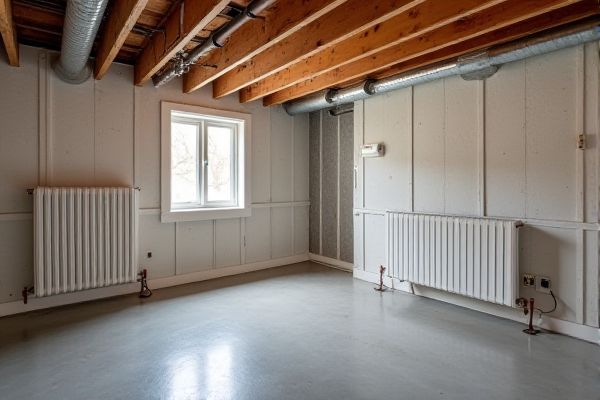
Radiant wall panels provide consistent, energy-efficient heat by warming walls and objects directly, creating a comfortable basement environment without the noise or airflow of portable heaters. Discover which heating solution best suits your basement's needs and how to maximize your comfort in the full article.
Table of Comparison
| Feature | Radiant Wall Panels | Portable Heaters (Basement) |
|---|---|---|
| Heating Method | Infrared radiation warms surfaces and objects | Convection or fan-based air heating |
| Installation | Wall-mounted, permanent | Plug-and-play, portable |
| Energy Efficiency | High efficiency with direct heat delivery | Moderate efficiency, may lose heat to surroundings |
| Heat Distribution | Even, consistent warmth across surfaces | Localized, may create hot spots |
| Safety | Low risk of tipping, cooler outer surface | Risk of tipping and overheating |
| Noise Level | Silent operation | May produce fan noise |
| Cost | Higher upfront cost, low running cost | Lower upfront cost, potentially higher running cost |
| Best Use | Permanent basement heating, energy saving | Temporary or supplemental basement heating |
Introduction to Basement Heating Solutions
Basement heating solutions include radiant wall panels and portable heaters, each offering unique benefits for maintaining comfortable temperatures. Radiant wall panels provide consistent, energy-efficient warmth by directly heating walls and objects, reducing cold spots and moisture issues common in basements. Portable heaters offer flexibility and quick heat but may lead to uneven warming and higher energy costs, making radiant panels a more sustainable choice for your basement comfort.
What Are Radiant Wall Panels?
Radiant wall panels are electric heating devices installed directly onto walls, emitting infrared heat that warms objects and people rather than just the air. Unlike portable heaters that rely on convection to heat the basement air, radiant panels provide consistent, energy-efficient warmth by targeting surfaces, reducing energy waste. Choosing radiant wall panels for your basement ensures more even heat distribution and a quieter, space-saving alternative to bulky portable heaters.
Overview of Portable Heaters
Portable heaters for basements provide flexible and immediate heating solutions, typically using electric resistance or propane fuel to generate warmth. These devices offer quick heat distribution and easy mobility, making them ideal for spot heating or temporary use in poorly insulated spaces. However, portable heaters can consume higher energy, require proper ventilation for fuel types, and may pose safety risks without adequate supervision.
Installation Process: Radiant Wall Panels vs. Portable Heaters
Radiant wall panels require a more involved installation process, often involving mounting on walls and electrical wiring by a professional to ensure optimal heat distribution and safety. Portable heaters offer a simple, plug-and-play solution with no permanent installation needed, making them ideal for quick, temporary heating in your basement. Your choice depends on whether you prioritize a permanent, energy-efficient heating system or the ease and flexibility of a portable unit.
Energy Efficiency Comparison
Radiant wall panels offer superior energy efficiency in basements by directly heating objects and occupants, minimizing heat loss compared to the air-based circulation of portable heaters. Portable heaters often consume more electricity as they work harder to maintain ambient temperature, especially in poorly insulated basement spaces. For your basement's energy management, choosing radiant wall panels can result in consistent warmth with lower energy consumption and reduced utility costs.
Heating Performance and Coverage
Radiant wall panels provide consistent, even heat by warming objects and surfaces directly, resulting in efficient heating with minimal energy loss. Portable heaters generate quick, localized warmth but often struggle to maintain uniform temperature across larger basement spaces, limiting overall coverage. Your choice depends on whether you prioritize sustained, widespread heating with radiant panels or intermittent, targeted warmth from a portable heater.
Safety Considerations in Basement Settings
Radiant wall panels offer increased safety in basement settings due to their fixed installation, reducing the risk of tip-overs and accidental contact with flammable materials common with portable heaters. These panels distribute heat evenly without exposed heating elements, minimizing fire hazards and carbon monoxide risks often associated with fuel-based portable heaters. Ensuring proper ventilation and placement for any heating device in your basement is critical to maintain a safe environment and prevent health issues.
Cost Analysis: Upfront and Ongoing Expenses
Radiant wall panels generally require higher upfront installation costs due to professional mounting and electrical work, but they offer lower ongoing energy expenses through efficient heat distribution. Portable heaters have minimal initial purchase costs and no installation fees, making them budget-friendly upfront options, but they often incur higher electricity bills over time because of less efficient, localized heating. Over the long term, radiant wall panels can provide more cost-effective heating solutions for basements compared to portable heaters, especially in larger or frequently used spaces.
Aesthetic and Space Impact
Radiant wall panels offer a sleek, low-profile design that integrates seamlessly into basement walls, preserving floor space and maintaining a clean, uncluttered aesthetic. Unlike bulky portable heaters, these panels eliminate the need for additional storage or obstruction of living areas, enhancing overall room functionality. Their discreet installation supports minimalistic decor while providing efficient, evenly distributed heat.
Choosing the Best Heating Option for Your Basement
Radiant wall panels provide efficient, even heat distribution ideal for maintaining consistent basement temperatures without taking up floor space, while portable heaters offer flexibility and easy relocation to targeted areas. Basements with limited insulation or high moisture benefit from radiant panels' dry heat to reduce dampness, whereas portable heaters may be suited for occasional use or smaller spaces. Consider your basement's size, insulation level, and heating frequency to select the most effective and energy-efficient solution for your comfort needs.
 homyna.com
homyna.com